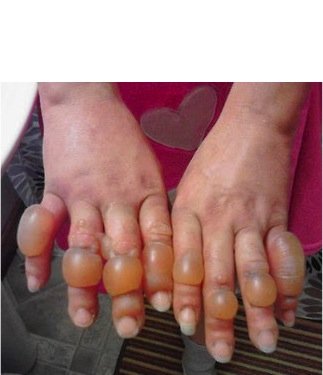Frostbite is a condition that occurs when skin and underlying tissues freeze due to exposure to cold temperatures. It occurs due to vasoconstriction, resulting in decreased blood flow (which would deliver heat) to tissues, and this leads to ice crystal formation. Frostbite most often occurs due to exposure at temperatures of less than -20°C (that includes wind chill). Freezing alone typically does not cause tissue damage. Thawing is what worsens the damage by disrupting the endothelium of cells. The blood flow of skin is normally around 250 ml/min, but in tissue damaged by frostbite, drops to 20-50 ml/min. This endothelial damage leads to swelling, platelet aggregation, and potentially thrombosis (in the form of microthrombi due to decreased intravascular flow).
Exposed and wet skin are the most likely to be damaged. Most likely areas are feet, hands, ears, lips, and nose. Risk factors for frostbite include patients that are colder temperatures, wind chill, no shelter, prolonged exposure, exposure while wet, patients with EtOH use. Patients with medical conditions that impact vasculature are also at increased risk, including diabetes, PVD, and smokers.
Classifications of Frostbite:
First Degree: Involves superficial skin freezing, causing redness and irritation, but usually has good recover
Symptoms include stinging and burning, eventually throbbing
Patients typically develop erythema, swelling, and have desquamation later
Second Degree: Involves freezing of the skin and deeper tissues, resulting in blistering and swelling, but usually has good recovery
Symptoms include numbness, then followed by aching and throbbing
Patients typically have extensive edema for hours, then develop blisters after that, and desquamate over the course of days
Third Degree: Involves freezing extending to subcutaneous tissues, leading to deep tissue damage, usually has poor recovery
Symptoms include extremities feeling heavy, then burning, throbbing, and shooting pains
Patient with third degree frostbite will develop hemorrhagic blisters
Fourth Degree: The most severe form, involving freezing of muscles, tendons, and bone, often leading to irreversible damage
Symptoms include a deep, aching pain
Skin becomes mottled, and deep eschar forms
Management:
Treat hypothermia first! Rewarm core temperature, otherwise at risk of reinjuring the patient if their extremities are re-exposed to cold again
Remove wet clothing
Place extremities in a 40-42°C bath for 20-30 min
Care should be made to not rewarm too quickly, otherwise you risk worsening reperfusion injuries
For areas that can not be placed in a bath (nose, ears, etc) can use a warm, wet towel
Rewarming is considerably painful and should be treated with aggressive pain control
Wound care should be undertaken
Wrap wounds with sterile, dry gauze
Keep effected extremities elevated
Do not remove blisters
Have a high clinical suspicion for possible compartment syndrome
Patients with full thickness injuries and no evidence of reperfusion after rewarming should be considered for tPa therapy which may reduce the risk of digital amputation
Patients should receive tetanus vaccination
Complications of frostbite
Patients can develop hypersensitivity to the cold with pain and ongoing numbness. Many patients can develop arthritis, can have loss of nails, cracked skin, atrophy of muscles. If tissue ischemia is severe, debridement may end up being necessary for extreme cases.
Example of Stage 3 injury
Basit H, Wallen TJ, Dudley C. Frostbite. [Updated 2023 Jun 26]. In: StatPearls [Internet]. Treasure Island (FL): StatPearls Publishing; 2023 Jan-Available from: https://www.ncbi.nlm.nih.gov/books/NBK536914/
Handford C, Thomas O, Imray CHE. Frostbite. Emerg Med Clin N Am. 2017;35(2):281–299.
Frostbite. Orthobullets. (n.d.). https://www.orthobullets.com/hand/12105/frostbite

